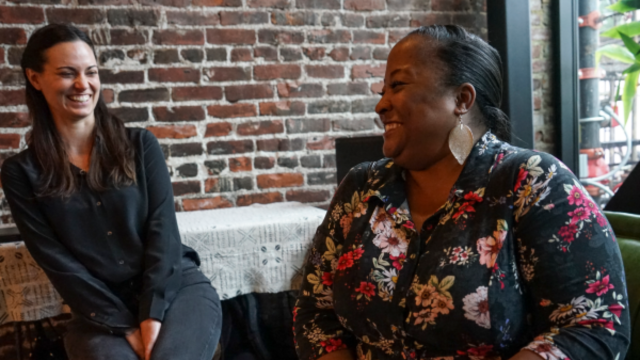Jeff Clarke, CEO
Relationships with elected officials at the local, state and federal levels are the center of policy work. Appropriately, these relationships are owned by our network members. Even if you can see your elected officials in the grocery store at home, opportunities like last week’s Foundations on the Hill in Washington, D.C. remain important sector moments. At the same time, these important relationships are but one of many necessary for influence within our large, complex policy ecosystem.
Building relationships within the administration and across agencies, at all levels of government, is equally important. But that part of the ecosystem is generally not well understood, can be difficult to access and experiences high turn-over. Given philanthropy’s emerging recognition of cross-sector collaboration as the key to building resilient, equitable and inclusive communities, mapping this part of the ecosystem and building relationships is a current focus of our policy work. During the last two weeks of March, Philanthropy Northwest has or will engage both here in our region and in Washington, D.C with a wide range of government officials around issues important to the Pacific Northwest, including:
- Rural communities with Lisa Mensah, USDA undersecretary for rural development and Doug O’Brien, White House senior policy advisor on rural affairs
- Native youth opportunity with the White House Office of Intergovernmental Affairs and White House Council on Native American Affairs
- My Brother’s Keeper with Michael Smith, White House Office of Cabinet Affairs
- Veterans and military family reintegration with Lt. Colonel Brian Gilman, Joint Chiefs of Staff
- Place-based public-private partnerships with the White House Domestic Policy Council, Office of Management & Budget, Office of Social Innovation and Center for Environmental Quality
- Building the next generation of outdoor stewards, United States Secretary of the Interior Sally Jewel
Generation Indigenous
While each of these meetings resulted in many important conversations and new announcements that deserve to be shared, I’d like to briefly focus on Generation Indigenous (Gen-I), a White House initiative that takes a comprehensive, culturally appropriate approach to help improve the lives of Native youth.
In June 2014, President Obama embarked on his first presidential visit to Indian Country and the Standing Rock Reservation, where he and Mrs. Obama witnessed how a myriad of social, economic, and educational problems have coalesced into a crisis for a most vulnerable population — Native youth. The specific struggles that Native youth face often go unmentioned in our nation’s discussions about America’s children. After this visit, President Obama challenged his administration to do more and do better. In a subsequent report, he called all Americans to work together to remove barriers that stand between Native youth and their opportunity to succeed.
At the 2014 White House Tribal Nations Conference, President Obama reaffirmed his commitment to education and economic development by announcing the launch of Generation Indigenous (Gen I), a Native youth initiative focused on removing barriers that stand between native youth and their opportunity to succeed. There, leaders from the 566 federally-recognized Native nations and, for the first time, 37 high-school aged “Gen-I” Native Youth Ambassadors were invited to engage with the President, Vice President, and Cabinet Officials representing the White House Council on Native American Affairs on key issues facing tribes.
Now, multiple agencies, including the Departments of the Interior, Education, Housing and Urban Development, Health and Human Services, Agriculture, Labor and Justice, are working collaboratively with tribes to implement education reforms and address issues facing Native youth. Current efforts to better coordinate and demonstrate results from across the Federal government to serve Native youth have been expanded by new investments that include:
- Extending broadband internet and computer access to all Bureau of Indian Education-funded schools and dormitories
- Addressing teacher housing needs
- Expanding youth-focused behavioral, mental health, and substance abuse services
- Supporting community-driven, comprehensive strategies to improve college and career-readiness of Native youth
As the White House builds upon Gen-I Initiative’s important and positive momentum, the plan, according to December 2014 press coverage, is to work cross-sector with tribal leaders and youth, philanthropy, nonprofits and policy makers.
Speaking of Building Cross-sector Relationships
Last week in Washington, D.C., Mission Investors Exchange, a long-time project of Philanthropy Northwest, and Council of Development Finance Agencies (CDFA) co-convened philanthropy and community development finance agencies to discuss ways we can work together to build resilient, equitable and inclusive communities. The long overdue conversation with CDFA, whose network of 55,000 state and local development finance agencies dedicated to fostering job creation and economic growth through the use of tax-exempt and other public-private partnership finance programs, did not disappoint.
Because philanthropy brought an impressive and creative cohort of fluent public finance veterans to the table, the discussion about economic development financing programs (e.g. tax-exempt and taxable bonds, credit enhancement programs, and direct debt and equity investments) moved quickly, focusing on philanthropy’s ability to bring patient, flexible and gap funding to both “but for”, or concessionary, and market-rate opportunities. However, the real conversation revolved entirely around our shared aspiration to organize demand for impact capital in communities — people and their place.
Another aspect we shared? An action orientation. With philanthropy expressing increased interest in building relationships with non-traditional partners around financial capital using both proven and emerging structures (e.g. social impact bonds), expect there to be plenty of action. Stay tuned.


